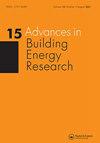A hybrid energy-saving prediction model based on SSA-DNN for district heating system
IF 2.5
Q2 CONSTRUCTION & BUILDING TECHNOLOGY
引用次数: 0
Abstract
ABSTRACT Accurate heat load prediction is a prerequisite for feed-forward control and on-demand heat supply in district heating system. However, considering that the experimental data used to train the prediction model are often not optimal or most energy efficient, accurate prediction is difficult to achieve effective energy-saving. This paper proposes a hybrid energy-saving prediction model that combines similar sample selection approach (SSA) and deep neural network. A new weighted Euclidean norm (WEN) is used to select suitable similar sample datasets, and a novel energy-saving strategy is proposed to reduce energy consumption. To make the prediction performance more stable, a low-pass filter is used to filter the prediction results. In the case study, real data from a heat exchange station in Tianjin are used to verify the prediction performance of the hybrid model for 1 test day, 3 test days, and 7 test days. Experimental results show that: (a) the proposed model is able to capture the change trend of heat load, with Pearson correlation coefficient of 0.971, 0.969, and 0.954 on different test days, respectively; (b) the proposed model is able to effectively reduce energy consumption, with energy-saving of 5.4%, 7.6%, and 4.8% on different test days, respectively.基于SSA-DNN的区域供热系统混合节能预测模型
摘要准确的热负荷预测是区域供热系统前馈控制和按需供热的前提。然而,考虑到用于训练预测模型的实验数据往往不是最优的或最节能的,准确的预测很难实现有效的节能。本文提出了一种将相似样本选择方法(SSA)和深度神经网络相结合的混合节能预测模型。使用一种新的加权欧几里得范数(WEN)来选择合适的相似样本数据集,并提出了一种新颖的节能策略来降低能耗。为了使预测性能更加稳定,使用低通滤波器对预测结果进行滤波。在案例研究中,使用天津某换热站的真实数据验证了混合模型在1个测试日、3个测试日和7个测试日的预测性能。实验结果表明:(a)所提出的模型能够捕捉热负荷的变化趋势,不同试验日的Pearson相关系数分别为0.971、0.969和0.954;(b) 该模型能够有效降低能耗,在不同的试验日分别节能5.4%、7.6%和4.8%。
本文章由计算机程序翻译,如有差异,请以英文原文为准。
求助全文
约1分钟内获得全文
求助全文
来源期刊

Advances in Building Energy Research
CONSTRUCTION & BUILDING TECHNOLOGY-
CiteScore
4.80
自引率
5.00%
发文量
11
 求助内容:
求助内容: 应助结果提醒方式:
应助结果提醒方式:


